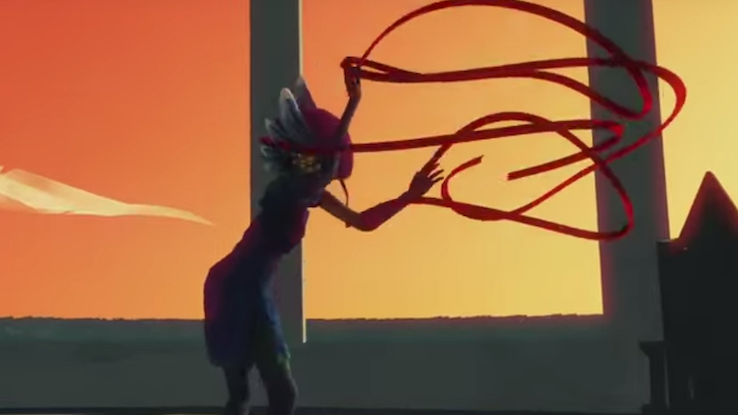 I’ve been catching up on some much overdue research this summer, and in the course of my reading, I’ve found myself thinking a lot about critique and immersion. Indeed, it would seem that, often, when people discuss critical thinking and scholarship in relation to video games, they usually work under the assumption that a certain amount of distance from a text is needed to be critical, as perhaps particularly evidenced, for example, by the very title of the Critical Distance site, a space dedicated to highlighting “thoughtful, incisive criticism, commentary and analysis” on video games.
I’ve been catching up on some much overdue research this summer, and in the course of my reading, I’ve found myself thinking a lot about critique and immersion. Indeed, it would seem that, often, when people discuss critical thinking and scholarship in relation to video games, they usually work under the assumption that a certain amount of distance from a text is needed to be critical, as perhaps particularly evidenced, for example, by the very title of the Critical Distance site, a space dedicated to highlighting “thoughtful, incisive criticism, commentary and analysis” on video games.
Gonzalo Frasca, for one, seems to work under a similar assumption, as evidenced by his contribution to First Person: New Media as Story, Performance, and Game, entitled “Videogames of the Oppressed: Critical Thinking, Education, Tolerance, and Other Trivial Issues,” in which Frasca argues that full immersion in a video game’s narrative causes us to lose the distance that he believes is needed for us to be able to be critically engaged with it. Yet, the idea of immersion also seems to be an important component in the manner in which we engage with a text, since scholars like Janet H. Murray argue that it’s one of the most distinctive and pleasurable characteristics of video games.
So, I guess, in thinking about all this, I wonder—how do we, as game scholars, navigate the seeming polarity between critical distance and ludic immersion? Are critical thinking and immersion necessarily mutually exclusive? Can one be critically engaged and fully immersed at the same time? Or if not, how much distance from a text is needed in order to be critical of it? In short, how do we negotiate critique and play?
 Honestly, I don’t know how I feel about the idea of distance. The implications bound up in the idea that we need to have some level of distance from a text, that we need to be, in a sense, emotionally removed from it in some way in order to achieve critical thinking, seem potentially problematic. It seems to perpetuate this idea of a divide—that scholars and critics and academics sit, removed from it all, up in their ivory tower surrounded by their books and their consoles (it’s a tech-savvy ivory tower). And the rest of the gaming world exists out there in the “real world” playing and making games while being fully immersed in their narratives and in the culture. This implied separation and this binaristic divide between critical scholar and fun-loving player seems to contain all the ingredients needed for unnecessary friction and conflict.
Honestly, I don’t know how I feel about the idea of distance. The implications bound up in the idea that we need to have some level of distance from a text, that we need to be, in a sense, emotionally removed from it in some way in order to achieve critical thinking, seem potentially problematic. It seems to perpetuate this idea of a divide—that scholars and critics and academics sit, removed from it all, up in their ivory tower surrounded by their books and their consoles (it’s a tech-savvy ivory tower). And the rest of the gaming world exists out there in the “real world” playing and making games while being fully immersed in their narratives and in the culture. This implied separation and this binaristic divide between critical scholar and fun-loving player seems to contain all the ingredients needed for unnecessary friction and conflict.
But it also seems to create a divide between critique and play—between critical thinking and the ability to have fun. It seems to say that the only way to have fun is to immerse ourselves in the games we play, to forget about thinking critically, to just get lost in the story. This seems to imply that there’s only one way to have fun, and that fun and critique are like oil and water. But who’s to say critical thinking isn’t fun? Who’s to say one person’s idea of fun is better than another’s? Who’s to say one version of fun and play is the definitive and only version there is? And ultimately, who’s to say that we can’t be critical and immersed—that we can’t have fun and think deeply about games—at the same time?
I don’t know. Maybe there actually is some value in distance. Maybe the trite expression of not being able to see the forest for the trees is a cliché for a reason. Maybe some distance allows for clarity of thought or the ability to engage with the bigger picture. But I think too much distance (and for too long) is potentially dangerous because there is the danger that we might become so critically distant that we become out of touch. That we disengage.
 In light of all this, it might be telling to return to Frasca, who, yes, argues in favor of critical distance in video game scholarship, but who also argues that video game scholarship should also include video game production. Perhaps we might conceive of production as a sort of immersion as well—immersion in the industry and in all it takes to make a game. Immersion as a sort of deeper connectivity to the creation process that results in a game’s mechanics and narrative, its world and its objectives. So maybe we can think about production as just a different type of immersion, and only one type among many. Maybe this is just a different way of thinking about all the ways we might immerse ourselves (as scholars, as critics, as players) in video games. We don’t just write about games. We play them too. Maybe some of us also produce them. And maybe some of us engage in some sort of activism within the community, immersing ourselves in proactive work that aims to make things better. Although maybe not enough of us do that. Maybe we can be immersing ourselves more in such work. Maybe we could be doing better in that regard.
In light of all this, it might be telling to return to Frasca, who, yes, argues in favor of critical distance in video game scholarship, but who also argues that video game scholarship should also include video game production. Perhaps we might conceive of production as a sort of immersion as well—immersion in the industry and in all it takes to make a game. Immersion as a sort of deeper connectivity to the creation process that results in a game’s mechanics and narrative, its world and its objectives. So maybe we can think about production as just a different type of immersion, and only one type among many. Maybe this is just a different way of thinking about all the ways we might immerse ourselves (as scholars, as critics, as players) in video games. We don’t just write about games. We play them too. Maybe some of us also produce them. And maybe some of us engage in some sort of activism within the community, immersing ourselves in proactive work that aims to make things better. Although maybe not enough of us do that. Maybe we can be immersing ourselves more in such work. Maybe we could be doing better in that regard.
I think, ultimately, what it comes down to is balance. And it also comes down to diversity. There are so many different ways to be critically engaged with a text or with a cultural construct. There are so many different ways to be immersed. There are so many different ways to play or have fun. To say that there’s one right way to do critique or that there’s one right way to have fun seems limited and exclusionary. And, really, to rely on such a hierarchy of critique and fun seems like no fun at all.




